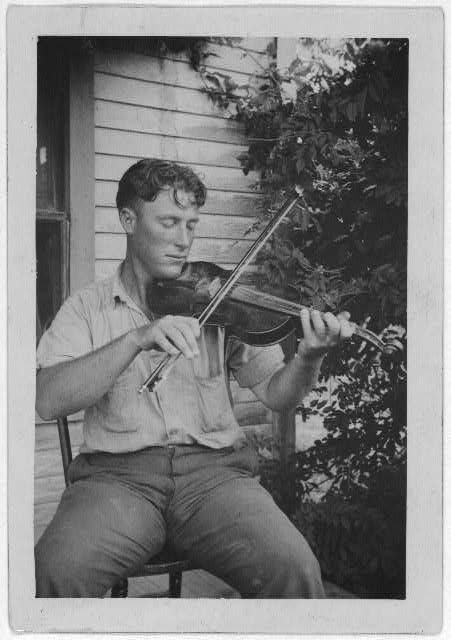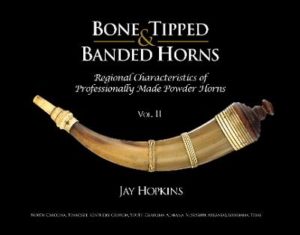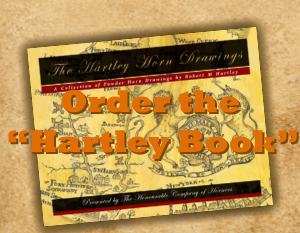January 2014 – Message from the Guildmaster
January 11, 2014 by Jeff Bibb
Filed under Message from the Guildmaster
Hello All:
Happy New Year! 2014 has arrived with a vengeance for much of the central and eastern portions of our country. Temperatures in central Virginia are expected to fall into the low single digits by tomorrow evening and extend into Tuesday. In the interim, we are watching freezing rain cover our mountainside with silvery highlights.
In colonial times one must suppose that these periods of bad weather were simply endured along with other hardships of the period. More logs were added to the fire, and perhaps a pot of stew was suspended in the fireplace in anticipation of a hot meal later in the day. Forced to stay inside, many folks turned to some form of entertainment to pass the dreary days ahead. For many that entertainment included music and dance.
History has shown that music was one of the most important recreational activities our ancestors participated in. In larger metropolitan areas, people could attend performances by various chamber ensembles, or perhaps participate in a formal “danse” held at homes or other venues. In the declining years of the Baroque period, people of higher social standing could listen to the works of an extraordinary list of composers. The Baroque era produced some of the most gifted musical minds our world has ever experienced, including J.S. Bach, George Handel, Antonio Vivaldi, Johann Pachelbel, Henry Purcell, and many others. Musical standards such as Pachelbel’s “Canon in D” are widely heard today at weddings and other occasions.
Music and dance were also very important for more common folks, especially in the remote mountain areas. Sometimes music might also save one’s life. When Lewis and Clark made their historic journey to the Pacific coast, several fiddlers were among their ranks, including George Gibson and Pierre Cruzatte. Cruzatte in particular was noted as “a fine fiddle player,” and admired for his skills at entertaining Native Americans while the party was in camp. On several occasions Lewis and Clark mention that Cruzatte’s musical skills may have saved them from hostile conflicts.
During the colonial period and settlement of our country, the musical traditions of European countries, along with African, Caribbean, and other areas came together in unique combinations that produced some highly individual American musical styles. The violin or “fiddle” as it is commonly referred to, was perhaps the most widely used instrument of the period for dances and performances. Irish, English and Scottish tunes comprised a large part of the fiddler’s repertoire, later evolving into versions that are still played and enjoyed today. Songs such as Soldier’s Joy, Over the Waterfall, Fisher’s Hornpipe, Liberty, La Bastringue, Silver Bells, and countless others provided a rich cross section of styles and techniques that evolved through the next several centuries. These fiddle tunes were the basis for many rural dances throughout the next century, and beyond.
My grandparents met at a “parlor” dance in the mid 1920’s here in Virginia. Such events were quite popular and provided welcome relief from hard work on the farms. My grandfather and great uncle played “Old Time” string band music on the fiddle and banjo for these events through the 1920’s and 1930’s. My grandfather’s policy was that “they would play until 12:00 AM. If the dancers wanted more music, they could find another band.” Like Cajun dances of the same period, these events were most often held in a home. The furniture was moved to the side along the walls, the rug was rolled up, and the dancers had a floor.
Along with the fiddle, other instruments were commonly played, and even invented, by our early settlers. Drums, whistles, pipes, zithers and other European instruments were used to make music. In more mountainous and rural areas the violin was a difficult instrument to make and care for. Its sharply rounded body, made from thinly carved wood, was a challenge for rural craftsmen. In addition the violin was somewhat fragile and required much more care to prevent its destruction. In the 1700’s the settlers of the Shenandoah Valley of southwest Pennsylvania and northern Virginia took elements of the European fretted zither and the psaltery, and began fashioning a long fretted instrument which was played in the lap, strummed with a feather quill, and noted with a small stick or feather quill. The Appalachian Dulcimer was the result and remains a very popular instrument for fiddle tunes and folk music today.
Music in the rural south followed a similar progression with some different developments. The banjo was a traditional African instrument, commonly made from a large dried gourd with an animal skin stretched over its top to provide resonance and volume. Many references can be found regarding slaves who were accomplished “banjer” players as well as talented fiddlers. Songs such as John Cherokee were very popular. This song is a traditional sailing song, sung by “checkerboard” crews, so named because they were comprised of white, African, and West Indian sailors, both freeman and slaves. It is noted as a popular work song that could be sung while loading or unloading cargo. In the rural south, work chants and songs of this type were very popular and provided a welcome diversion from the hard manual labor of the singers. Some of these work songs, combined with better instrumentation, later evolved into more complex musical patterns. In the early 20th. Century, rural southern black music formed the basis for blues, and elements of jazz, perhaps some of the most influential musical forms in our history.

Wayne Perry playing fiddle, Crowley, Louisiana.
Further south in rural, southwest Louisiana, another group of settlers were developing their own musical styles. When the French “Acadians” were forced out of Canada in the mid 1700’s by the British, many settled in the prairies and bayous of Louisiana. These French speaking people had a lot of interaction with Caribbean people who landed in their area through shipping and trading. Through this association, some of the most important elements of “Cajun” music were born.
In the Antilles and San Domingo, a voodoo dance known as “Calinda” was performed in a ritual manner, often involving fighting with sticks. The participants did not always survive unscathed. This dance was brought with the Caribbean people to the Cajun areas, and mixed with the traditional French folks tunes. The name “Colinda” came into widespread use as a somewhat risqué song and dance that the young Cajun French grew quite fond of. The dance was officially banned in 1843 as being “inappropriate,“ but has survived to this day.
Very old, traditional Cajun music is noted for blending African syncopated rhythms with French folk songs, most often played on a pair of fiddles. The result was a highly charged musical style with an emphasis on dancing and singing. In the early part of the 20th. century, the famous Cajun fiddler, Dennis McGee recorded a song named “Madame Young.” This song (with a different title) was taken directly from the original “Colinda” melody. McGee was born in the late 1800’s and grew up listening to and learning traditional Cajun songs from the 18th. And 19th. Centuries. His influence on Cajun music is still heard today.
I suppose the point of these examples is to underscore the importance of our colonial settlers’ contributions to our cultural growth as a nation. Over the past two centuries our country has produced some of the most diverse and influential popular musical styles known. With the cultural merging of so many countries and traditions, our ancestors began the creation of a rich musical legacy that continues to this day. Music has always been an important element in most people’s lives, and I hope the value of these contributions will be appreciated for centuries to come.
As always, your comments, criticisms, and other observations are always welcome.
Thank you,
Jeff Bibb
Guildmaster




